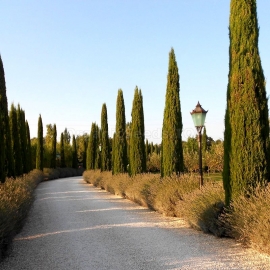




Organic Italian Cypress Seeds (Cupressus Sempervirens)
1.39 €
Cupressus sempervirens, commonly known as the Mediterranean Cypress or Pencil pine, is a species of cypress native to the eastern Mediterranean region, in northeast Libya, southeast Greece), southern Turkey, Cyprus, western Syria, Lebanon and Jordan.
-
Organic Italian Cypress (Cupressus Sempervirens)
Cupressus sempervirens, commonly known as the Mediterranean Cypress or Pencil pine, is a species of cypress native to the eastern Mediterranean region, in northeast Libya, southeast Greece), southern Turkey, Cyprus, western Syria, Lebanon and Jordan.
It is a medium-sized evergreen tree to 35 m in height, with a conic crown with level branches and variably pendulous branchlets. It is very long-lived, with some trees reported to be over 1,000 years old. The foliage grows in dense sprays, dark green in colour. The leaves are scale-like, 2-5 mm long, and produced on rounded shoots. The seed cones are ovoid or oblong, 25-40 mm long, with 10-14 scales, green at first, maturing to a golden brown.
The male cones are 3-5 mm long. Mediterranean Cypress has been widely cultivated as an ornamental tree for millennia away from its native range, mainly throughout the central and western Mediterranean region, and in other areas with similar hot, dry summers and mild, rainy winters. Pencil pines are hardy and will grow in all but the most severe climatic zones of Australia. They are also more tolerant of dry conditions than most other cypresses. It makes an excellent bonsai subject.
How to Grow
Italian Cypress seeds are relatively easy to germinate and grow. The dormancy within the seed is short and easily broken. This is achieved by a short period of cold stratification in the fridge.
You can do this by first soaking the seeds in water for 24 hours. Fully drain away all of the water and place the seeds in a zip-lock freezer bag. Place the seeds in the fridge, it is important that during this period that the seeds do not dry out or are waterlogged otherwise the pre-treatment will be ineffective.
After between 4-6 weeks under these conditions the seeds are ready to be sown. In general many of the seeds will fail to germinate unless treated in this way, simply sowing untreated seeds in compost at room temperature will not break down the dormancy and germination will be disappointing.
Fill your chosen container with a good quality general potting compost. Suitable containers could be plant pots, seed trays or plug trays or even improvised containers with drainage holes. Firm the compost gently and sow the seeds on the surface. If you are sowing in plug trays, sow 2 or 3 seeds per cell. Cover the seeds with a thin layer of sieved compost or vermiculite
Follow with a gentle watering and keep them at room temperature in a place with plenty of light but not full sun. Maintain a high humidity around the seeds until germination starts and then provide good ventilation as the seedlings are very susceptible to fungal diseases such as damping off .
Germination should begin a few weeks from sowing. The seedlings are reasonably robust and trouble free and usually grow to a height of between 5 and 10 cm in the first growing season depending on the sowing date and cultural techniques.
Developing seedlings should be fine in full sun, keep them well watered and free of competing weeds. Growth will accelerate during the second and subsequent years and the developing young trees should be re-potted as necessary preferably during the dormant season. After 2 or 3 years they are ready to be planted in their permanent position.
